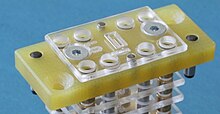Plug adapter
A plug adapter is an adapter for direct contact with the finest plugs , so that the testing of circuit boards or cable connections can be carried out efficiently and cost-effectively. Thanks to the precise contacting with rigid needles , such an adapter can make several 100,000 contacts before the rigid needles have to be replaced in service.
function
Rigid needles are positioned in the plug adapter for the corresponding contact points, which hit the plug contact through the contact stroke. Care is taken to ensure that the contacting force does not act vertically on the connector, but rather laterally on the contact points of the connector. This tries to prevent a possible interruption between the plug and the circuit board from being closed by the contacting force.
commitment
In the case of smaller test devices, the plugs are inserted into the plug adapter by hand and precisely positioned using the housing, which means that very fine plug structures can be broken up. After the test, the plug is lifted out of the adapter via an additional contacting stroke for removal.
If the connector adapter is used in a fully automatic machine, the adapter must be individually aligned with each connector. For this purpose, the position of the connector is recorded by a camera system and the contact is then corrected with the corresponding correction values in X, Y and Theta. However, this correction must be carried out extremely precisely so that the rigid needles of the adapter are not destroyed.
Options of the plug adapter
The distance between the plug contacts must be> 250 µm and the plug contact width> 150 µm. The contact force is between 0.6 N and 0.8 N. Multi-pole plugs can tap up to 200 test points / cm². The stroke can be triggered mechanically or pneumatically.

